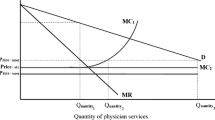ABSTRACT
BACKGROUND
Prior literature suggests that the fragmented U.S. health care system places a large administrative burden on physicians. Less is known about how this burden varies with physician contracting practices.
OBJECTIVE
To assess the extent to which physician practice outcomes vary with the number of managed care contracts held or the availability of such contracts.
DESIGN, PARTICIPANTS, AND MAIN MEASURES
We perform secondary data analyses of the first four rounds of the nationally representative Community Tracking Study Physician Survey (1996–2005), which includes 36,340 physicians (21,567 PCPs [primary care physicians] and 14,773 specialists) across the four survey periods. Our measures include reported hours in patient care, share of hours outside patient care, adequacy of time with patients, career satisfaction, and income.
RESULTS
Doctors who contract with more plans report spending more time in patient care (per 11 additional contracts, about 30 min per week for PCPs and 20 min per week for specialists), report spending a modestly larger share of their time outside patient care (per 11 additional contracts, about 10 min per week for PCPs and specialists), are slightly more likely to report inadequate time with patients (odds ratio 1.005 per additional contract for PCPs), and earn higher incomes (per 11 additional contracts, about 3 % more per year for specialists).
CONCLUSIONS
Contracting opportunities confer significant benefits on physicians, although they do add modest costs in terms of time spent outside patient care and lower adequacy of time with patients. Simplifications that reduce the administrative burden of contracting may improve care by optimizing allocation of physician effort.
Similar content being viewed by others
REFERENCES
Keehan S, Sisko A, Truffer C, et al. Health spending projections through 2017: the baby-boom generation is coming to Medicare. Health Aff. 2008;27:w145–55.
Blanchfield BB, Heffernan JL, Osgood B, Sheehan RR, Meyer GS. Saving billions of dollars—and physicians’ time—by streamlining billing practices. Health Aff. 2010;29:1248–54.
Cutler DM, Ly DP. The (paper)work of medicine: understanding international medical costs. J Econ Perspect. 2011;25:3–25.
Casalino LP, Nicholson S, Gans DN, et al. What does it cost physician practices to interact with health insurance plans? Health Aff. 2009;28:w533–43.
Spicer J. Making patient care easier under multiple managed care plans. Fam Pract Manag. 1998;5:38–53.
Glied SA, Zivin JG. How do doctors behave when some (but not all) of their patients are in managed care? J Health Econ. 2002;21:337–53.
Williamson OE. Transaction cost economics: the governance of contractual relations. J Law Econ. 1979;22:233–61.
Dafny L, Duggan M, Ramanarayanan D. Paying a premium on your premium? Consolidation in the U.S. health insurance industry. Working Paper No.15434. http://www.nber.org/papers/w15434. Accessed February 17, 2013.
Pear R. Health law is fostering competition, U.S. says. New York Times. 2013. http://www.nytimes.com/2013/05/31/health/health-law-is-fostering-competition-administration-says.html. Accessed June 8, 2013.
White House. Early results: competition, choice, and affordable coverage in the health insurance marketplace in 2014. 2013. http://www.whitehouse.gov/sites/default/files/docs/competition_memo_5-30-13.pdf. Accessed June 18, 2013.
While the Center for Health System Change has released a more recent Physician Survey (2008), the public file from this more recent survey was not designed to provide site specific estimates nor does it contain several variables of interest, including the exact number of managed care contracts or number of physician hours in patient care.
American Medical Association. Competition in Health Insurance: a comprehensive study of US Markets. Chicago: American Medical Association; 2002.
This figure of ten min is more precisely estimated by doing a regression of number of hours in non-medically related activities (calculated by subtracting the number of hours in medically-related activities by the number of hours in patient care) on number of contracts, controlling for physician characteristics.
Cutler DM, Winkler E, Basch P. Reducing administrative costs and improving the health care system. NEJM. 2012;367:1875–8.
Centers for Medicare and Medicaid Services. Deadlines and key dates: HIPAA administrative simplification compliance. 2013. http://www.cms.gov/Regulations-and-Guidance/HIPAA-Administrative-Simplification/Affordable-Care-Act/Downloads/Deadlines-and-Key.pdf. Accessed June 23, 2013.
Funding/Support
None disclosed.
Conflict of Interest
The authors declare they do not have any conflicts of interest.
Author information
Authors and Affiliations
Corresponding author
Rights and permissions
About this article
Cite this article
Ly, D.P., Glied, S.A. The Impact of Managed Care Contracting on Physicians. J GEN INTERN MED 29, 237–242 (2014). https://doi.org/10.1007/s11606-013-2589-8
Published:
Issue Date:
DOI: https://doi.org/10.1007/s11606-013-2589-8



